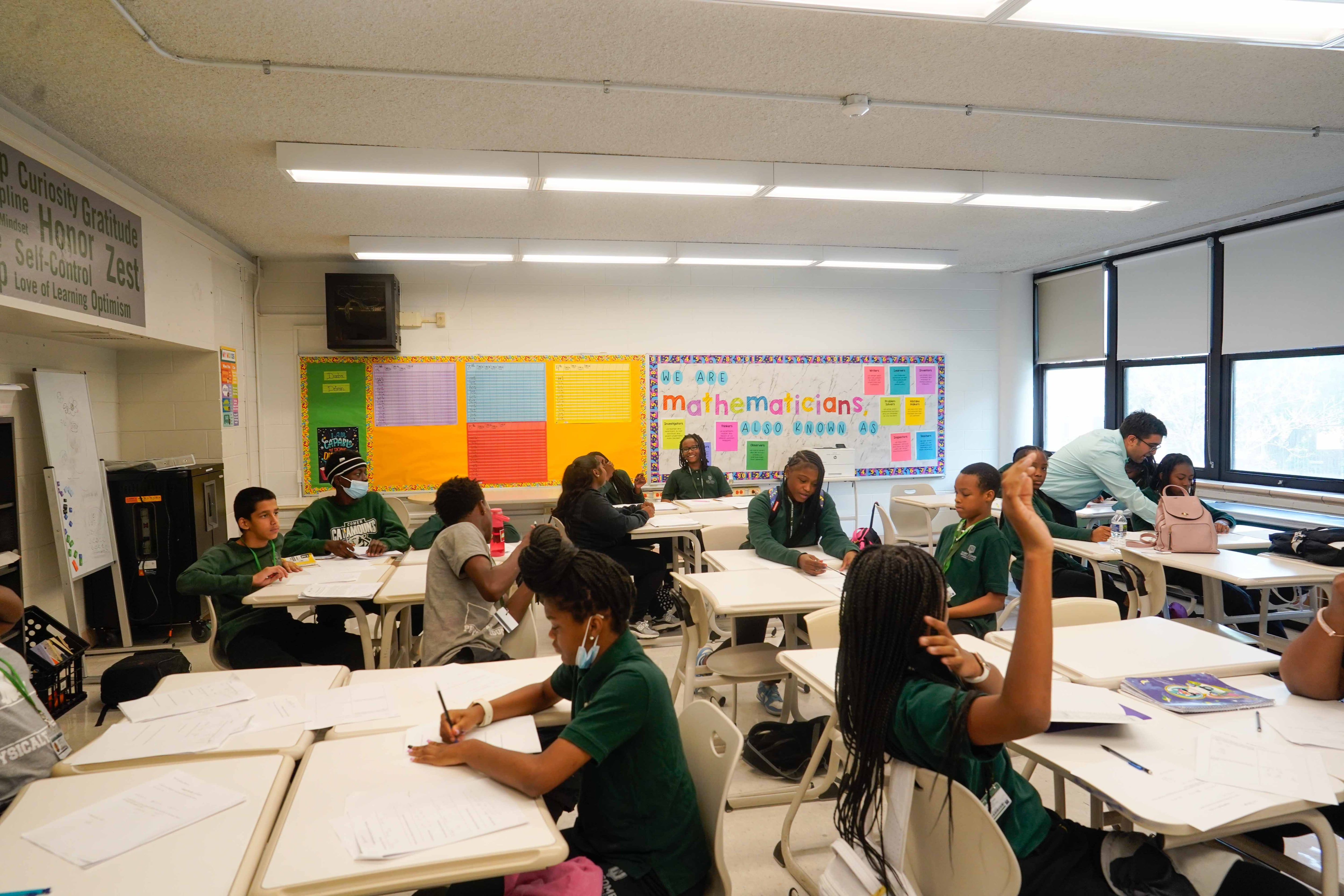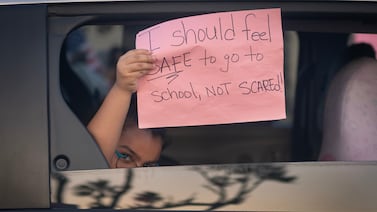Illinois public school students made strides in recovering from pandemic disruption, with gains in English language arts and math test scores, a jump in high school graduation rates in the past decade, and an increase in students taking advanced courses, according to data from the state’s latest report card.
The report card issued by the Illinois State Board of Education shows that more students were considered proficient on standardized tests in the 2022-23 school year compared to the previous year, but scores have yet to return to pre-pandemic levels.
In a press conference on Wednesday, State Superintendent Tony Sanders said educators and families should be proud of the progress made on the 2023 report card.
“I’m so happy to see a second year of strong recovery post-pandemic,” said Sanders. “We’re moving fast toward recovery, although we still have quite a distance to travel.”
The annual report card provides families and educators with a glimpse at how their district and school are doing in comparison to the state’s 850-plus districts. Among the metrics collected by the State Board of Education are test scores, enrollment data, chronic absenteeism, teacher retention rates, graduation rates, the number of students taking advanced coursework such as Advanced Placement or dual credit, and participation in career and technical education programs.
The latest report card offers some good news for Illinois districts that are still working to help students recover from pandemic-related disruptions. To address learning gaps, they have focused on hiring more staff, creating after-school programs, and hosting summer learning opportunities. Some of those efforts were funded with the $7 billion in federal COVID relief funding the state received.
However, the state’s public schools will have to figure out how to continue these programs as federal relief funding will expire at the end of September 2024. Chicago Public Schools officials recently projected a $391 million budget deficit next school year.
Here are some of the highlights from the 2023 report card.
Test scores are trending up, but haven’t returned to 2019 levels
Illinois standardized test scores show that reading recovery continues to improve while math scores have yet to make similar progress. While all student groups across race and ethnicity made significant gains, the report card found that Black students made the most progress. The state board noted that Black students were hit the hardest in the pandemic and often remained in remote learning longer than other students when school buildings began to reopen in the school year 2020-2021.
On the 2023 Illinois Assessment of Readiness, known as the IAR, a yearly standardized test used as one of the measures in the report card, 35.4% of students between third grade and eighth grade were proficient in reading, a 5.2 percent point increase compared to 2022. In math, 27% of students in those same grades were proficient, a 1.6 percentage point increase. However, the 2023 scores still fell short of pre-pandemic levels; in 2019, 37.8% were proficient in English language arts and 31.8% in math.
Last month, Chicago Public Schools reported about 26% of students were considered proficient in English Language Arts on the 2023 IAR test, compared with 27.3% in 2019. For math, 17.5% of students passed, compared with 23.6% in 2019.
Students were unable to take the spring assessment in 2020 when the pandemic upended learning and forced school buildings to close. In 2021, participation was low as some schools had the option of offering the exam in the spring or in the fall, but participation rates returned to normal in 2022.
For 11th graders who took the SAT, a standardized exam used by colleges as part of admission criteria, 31.6% of students were considered proficient in reading and 26.7% were considered proficient in math. That’s fewer than the 36.2% of 11th graders in 2019 who scored proficient in reading and the 34.4% who scored proficient in math.
State sees increase in enrollment for English learners
The state’s overall enrollment continues to decline steadily. Over 1.8 million students were enrolled in Illinois public schools in 2022-23, a loss of more than 11,500 students compared to the previous school year. In a media call on Wednesday, Sanders said the declines track with a drop in birth rates across the nation and in Illinois.
Public schools saw an increase of Latino and Asian American students enrolling last school year. However, white and Black student enrollment has decreased.
Across student groups, English language learners had the largest bump in enrollment over the last five years, according to the report card. Sanders said the state board cannot say for sure how many students are migrants from Central America or refugee students from Ukraine or Afghanistan.
Students continue to be chronically absent at high rate
About 28% of students were chronically absent from school last year. That’s a slight decrease — about a 1.5 percentage point — from the 2021-22 school year when about 29.8% of students were chronically absent.
Students are considered chronically absent when they miss about 18 days, or 10% of school, with or without a valid excuse. Student mental health days also count towards chronic absenteeism.
When students miss a significant amount of school it can impact their academic performance.
The report card shows high rates of absenteeism among Black, Native American, and Latino students. But Black, Latino, Asian American, and white students also saw improvement in school attendance compared in 2021-22. During last school year, chronic absenteeism rates were high among students from low-income families, students experiencing homelessness, and students with Individualized Education Programs.
The Illinois data is similar to what schools are seeing across the country. Attendance Works — a nonprofit organization that looks into attendance rates across the country — has seen early data from 11 states that found about 27.9% of students were chronically absent during the 2022-23 school year — a 2.2% decrease in chronic absenteeism rates compared with the 2021-22 school year.
Illinois students graduation rates improve
High school seniors who graduated in the spring of 2023 entered high school in 2019. Their freshman year was disrupted in March when COVID-19 shuttered schools. Now state data shows that those students graduated at the highest rate in 13 years, excluding 2019-20 when graduation rates were inflated due to a reduction in graduation requirements in the spring of 2020.
Last school year, 87.6% of students graduated from high school, a 1.4% increase from 2019 and a 3.8% increase from 2011. Black and Latino students saw significant gains when it comes to graduation rates compared to 2019 — 80.1% of Black students, or a 3.6% increase, and 88.5% of Latino students, a 6.3% gain, graduated from high school in the spring of 2023.
During the press conference on Wednesday, Sanders was asked what factor led to higher student achievement for Black students when compared to previous years. Sanders attributed much of it to the evidence-based funding formula.
“The investment that local school districts have been making to better support our students of color is, I think, why you’re seeing some of these significant increases not only in student proficiency, but also in graduation rates and other key indicators,” said Sanders.
Samantha Smylie is the state education reporter for Chalkbeat Chicago, covering school districts across the state, legislation, special education, and the state board of education. Contact Samantha at ssmylie@chalkbeat.org.






